Synthesis, X-ray Structure, Hirshfeld Surface Analysis and Antimicrobial Assessment of Tetranuclear s-Triazine Hydrazine Schiff Base Ligand
Abstract
1. Introduction
2. Results and Discussion
2.1. Synthesis and Characterization
2.2. X-ray Structure Description
2.3. Analysis of Molecular Packing
2.4. Antimicrobial Studies
3. Materials and Methods
3.1. Physical Measurements
3.2. Preparation of HDPPT
3.3. Synthesis of [Cu4(DPPT)2Cl6] Complex
3.4. X-ray Crystallography
3.5. Hirshfeld Surface Analysis
3.6. Antimicrobial Assay
4. Conclusions
Supplementary Materials
Author Contributions
Funding
Data Availability Statement
Acknowledgments
Conflicts of Interest
References
- Huang, F.; Anslyn, E.V. Introduction: Supramolecular Chemistry. Chem. Rev. 2015, 115, 6999–7000. [Google Scholar] [CrossRef] [PubMed]
- de Silva, A.P.; Sandanayake, K.R.A.S. Fluorescent PET (photo-induced electron transfer) sensors for alkali metal ions with improved selectivity against protons and with predictable binding constants. J. Chem. Soc. 1989, 16, 1183–1185. [Google Scholar] [CrossRef]
- Nakahata, M.; Mori, S.; Takashima, Y.; Yamaguchi, H.; Harada, A. Self-Healing Materials Formed by Cross-Linked Polyrotaxanes with Reversible Bonds. Chem 2016, 1, 766–775. [Google Scholar] [CrossRef]
- Wu, J.R.; Cai, L.H.; Weitz, D.A. Tough Self-Healing Elastomers by Molecular Enforced Integration of Covalent and Reversible Networks. Adv. Mater. 2017, 29, 8. [Google Scholar] [CrossRef] [PubMed]
- Jagleniec, D.; Dobrzycki, L.; Karbarz, M. Romanski, Ion-pair induced supramolecular assembly formation for selective extraction and sensing of potassium sulfate. J. Chem. Sci. 2019, 10, 9542–9547. [Google Scholar]
- Crane, B.C.; Barwell, N.P.; Gopal, P.; Gopichand, M.; Higgs, T.; James, T.D.; Jones, C.M.; Mackenzie, A.; Mulavisala, K.P.; Paterson, W. Advances in applied supramolecular technologies. J. Diabetes Sci. Technol. 2015, 9, 751–761. [Google Scholar] [CrossRef]
- Williams, N.J.; Seipp, C.A.; Garrabrant, K.A.; Custelcean, R.; Holguin, E.; Keum, J.K.; Ellis, R.J.; Moyer, B.A. Surprisingly selective sulfate extraction by a simple monofunctional di(imino)guanidinium micelle-forming anion receptor. Chem. Commun. 2018, 54, 10048–10051. [Google Scholar] [CrossRef]
- Mir, M.H.; Koh, L.L.; Tan, G.K.; Vittal, J.J. Single-Crystal to Single-Crystal Photochemical Structural Transformations of Interpenetrated 3D Coordination Polymers by [2 + 2] Cycloaddition Reactions. Angew. Chem. Int. Ed. 2010, 49, 390–393. [Google Scholar] [CrossRef]
- Das, L.K.; Gómez-García, C.J.; Ghosh, A. Influence of the central metal ion in controlling the self-assembly and magnetic properties of 2D coordination polymers derived from [(NiL)2M]2+ nodes (M = Ni, Zn and Cd) (H2L = salen-type di-Schiff base) and dicyanamide spacers. Dalton Trans. 2015, 44, 1292–1302. [Google Scholar] [CrossRef]
- Das, L.K.; Diaz, C.; Ghosh, A. Antiferromagnetic mixed-valence Cu (I)–Cu (II) two-dimensional coordination polymers constructed by double oximato bridged Cu(II) dimers and CuISCN based one-dimensional anionic chains. Cryst. Growth Des. 2015, 15, 3939–3949. [Google Scholar] [CrossRef]
- Yamada, T.; Otsubo, K.; Makiura, R.; Kitagawa, H. Designer coordination polymers: Dimensional crossover architectures and proton conduction. Chem. Soc. Rev. 2013, 42, 6655–6669. [Google Scholar] [CrossRef] [PubMed]
- Li, H.; Wang, Y.; He, Y.; Xu, Z.; Zhao, X.; Han, Y. Synthesis of several novel coordination complexes: Ion exchange, magnetic and photocatalytic studies. New J. Chem. 2017, 41, 1046–1056. [Google Scholar] [CrossRef]
- Mondal, M.; Jana, S.; Drew, M.G.; Ghosh, A. Application of two Cu (II)-azido based 1D coordination polymers in optoelectronic device: Structural characterization and experimental studies. Polymer 2020, 204, 122815. [Google Scholar] [CrossRef]
- Zhang, Z.; Zhao, Y.; Gong, Q.; Li, Z.; Li, J. MOFs for CO2 capture and separation from flue gas mixtures: The effect of multifunctional sites on their adsorption capacity and selectivity. Chem. Commun. 2013, 49, 653–661. [Google Scholar] [CrossRef] [PubMed]
- Zeng, L.W.; Hu, K.Q.; Mei, L.; Li, F.Z.; Huang, Z.W.; An, S.W.; Chai, Z.F.; Shi, W.Q. Structural diversity of bipyridinium-based uranyl coordination polymers: Synthesis, characterization, and ion-exchange application. Inorg. Chem. 2019, 58, 14075–14084. [Google Scholar] [CrossRef] [PubMed]
- Benesperi, I.; Singh, R.; Freitag, M. Copper coordination complexes for energy-relevant applications. Energies 2020, 13, 2198. [Google Scholar] [CrossRef]
- Kardos, J.; Héja, L.; Simon, Á.; Jablonkai, I.; Kovács, R.; Jemnitz, K. Copper signalling: Causes and consequences. Cell Commun. Signal. 2018, 16, 1–22. [Google Scholar] [CrossRef]
- Georgopoulos, G.; Roy, A.; Yonone-Lioy, M.J.; Opiekun, R.E.; Lioy, P.J. Environmental copper: Its dynamics and human exposure issues. J. Toxicol. Environ. Health Part B Crit. Rev. 2001, 4, 341–394. [Google Scholar] [CrossRef]
- Tapia, L.; González-Agüero, M.; Cisternas, M.F.; Suazo, M.; Cambiazo, V.; Uauy, R.; González, M. Metallothionein is crucial for safe intracellular copper storage and cell survival at normal and supra-physiological exposure levels. Biochem. J. 2004, 378, 617–624. [Google Scholar] [CrossRef]
- Neumann, W.; Gulati, A.; Nolan, E.M. Metal homeostasis in infectious disease: Recent advances in bacterial metallophores and the human metal-withholding response. Curr. Opin. Chem. Biol. 2017, 37, 10–18. [Google Scholar] [CrossRef]
- Srivastava, S.; Panda, S.; Li, Z.; Fuhs, S.R.; Hunter, T.; Thiele, D.J.; Hubbard, S.R.; Skolnik, E.Y. Histidine phosphorylation relieves copper inhibition in the mammalian potassium channel KCa3.1. Elife 2016, 5, e16093. [Google Scholar] [CrossRef]
- Sun, T.-S.; Ju, X.; Gao, H.-L.; Wang, T.; Thiele, D.J.; Li, J.-Y.; Wang, Z.-Y.; Ding, C. Reciprocal functions of Cryptococcus neoformans copper homeostasis machinery during pulmonary infection and meningoencephalitis. Nat. Commun. 2014, 5, 5550. [Google Scholar] [CrossRef]
- Wiemann, P.; Perevitsky, A.; Lim, F.Y.; Shadkchan, Y.; Knox, B.P.; Figueora, J.A.L.; Choera, T.; Niu, M.; Steinberger, A.J.; Wüthrich, M. Aspergillus fumigatus copper export machinery and reactive oxygen intermediate defense counter host copper-mediated oxidative antimicrobial offense. Cell Rep. 2017, 19, 1008–1021. [Google Scholar] [CrossRef]
- Liu, L.; Geng, X.; McDermott, J.; Shen, J.; Corbin, C.; Xuan, S.; Kim, J.; Zuo, L.; Liu, Z. Copper deficiency in the lungs of TNF-α transgenic mice. Front. Physiol. 2016, 7, 234–249. [Google Scholar] [CrossRef] [PubMed]
- Cypryk, W.; Lorey, M.; Puustinen, A.; Nyman, T.A.; Matikainen, S. Proteomic and bioinformatic characterization of extracellular vesicles released from human macrophages upon influenza A virus infection. J. Proteome Res. 2017, 16, 217–227. [Google Scholar] [CrossRef] [PubMed]
- Blockhuys, S.; Wittung-Stafshede, P. Roles of copper-binding proteins in breast cancer. Int. J. Mol. Sci. 2017, 18, 871. [Google Scholar] [CrossRef] [PubMed]
- Bandmann, O.; Weiss, K.H.; Kaler, S.G. Wilson’s disease and other neurological copper disorders. Lancet Neurol. 2015, 14, 103–113. [Google Scholar] [CrossRef] [PubMed]
- Bansagi, B.; Lewis-Smith, D.; Pal, E.; Duff, J.; Griffin, H.; Pyle, A.; Müller, J.S.; Rudas, G.; Aranyi, Z.; Lochmüller, H. Phenotypic convergence of Menkes and Wilson disease. Neurol. Genet. 2016, 2, e119. [Google Scholar] [CrossRef]
- Manto, M. Abnormal copper homeostasis: Mechanisms and roles in neurodegeneration. Toxics 2014, 2, 327–345. [Google Scholar] [CrossRef]
- Viles, J.H. Metal ions and amyloid fiber formation in neurodegenerative diseases. Copper, zinc and iron in Alzheimer’s, Parkinson’s and prion diseases. Coord. Chem. Rev. 2012, 256, 2271–2284. [Google Scholar] [CrossRef]
- He, Y.; Li, B.; O’Keeffe, M.; Chen, B. Multifunctional metal–organic frameworks constructed from meta-benzenedicarboxylate units. Chem. Soc. Rev. 2014, 43, 5618–5656. [Google Scholar] [CrossRef] [PubMed]
- Lee, M.M.; Kim, H.Y.; Hwang, I.H.; Bae, J.M.; Kim, C.; Yo, C.H.; Kim, Y.; Kim, S.J. Cd II MOFs Constructed Using Succinate and Bipyridyl Ligands: Photoluminescence and Heterogeneous Catalytic Activity. Bull. Korean Chem. Soc. 2014, 35, 1777–1783. [Google Scholar] [CrossRef][Green Version]
- Memon, Q.S.; Memon, N.; Mallah, A.; Soomro, R.; Khuhawar, Y.M. Schiff bases as chelating reagents for metal ions analysis. Curr. Anal. Chem. 2014, 10, 393–417. [Google Scholar] [CrossRef]
- Abu-Dief, A.M.; Mohamed, I.M.A. A review on versatile applications of transition metal complexes incorporating Schiff bases. Beni-Seuf Univ. J. Appl. 2015, 4, 119–133. [Google Scholar] [CrossRef] [PubMed]
- Al Zoubi, W. Solvent extraction of metal ions by use of Schiff bases. J. Coord. Chem. 2013, 66, 2264–2289. [Google Scholar] [CrossRef]
- Rezaeivala, M.; Keypour, H. Schiff base and non-Schiff base macrocyclic ligands and complexes incorporating the pyridine moiety–The first 50 years. Coord. Chem. Rev. 2014, 280, 203–253. [Google Scholar] [CrossRef]
- Liu, X.; Hamon, J.R. Recent developments in penta-, hexa-and heptadentate Schiff base ligands and their metal complexes. Coord. Chem. Rev. 2019, 389, 94–118. [Google Scholar] [CrossRef]
- Barakat, A.; El-Faham, A.; Haukka, M.; Al-Majid, A.M.; Soliman, S.M. s-Triazine pincer ligands: Synthesis of their metal complexes, coordination behavior, and applications. App. Organomet. Chem. 2021, 35, e6317. [Google Scholar] [CrossRef]
- Fathalla, E.M.; Abu-Youssef, M.A.M.; Sharaf, M.M.; El-Faham, A.; Barakat, A.; Haukka, M.; Soliman, S.M. Synthesis, X-ray Structure of Two Hexa-Coordinated Ni(II) Complexes with s-Triazine Hydrazine Schiff Base Ligand. Inorganics 2023, 11, 222. [Google Scholar] [CrossRef]
- Fathalla, E.M.; Abu-Youssef, M.A.M.; Sharaf, M.M.; El-Faham, A.; Barakat, A.; Badr, A.M.A.; Soliman, S.M.; Slawin, A.M.Z.; Woollins, J.D. Synthesis, Characterizations, Antitumor and Antimicrobial Evaluations of Novel Mn(II) and Cu(II) Complexes with NNN-tridentate s-Triazine-Schiff base Ligand. Inorg. Chim. Acta 2023, 555, 121586. [Google Scholar] [CrossRef]
- Fathalla, E.M.; Abu-Youssef, M.A.M.; Sharaf, M.M.; El-Faham, A.; Barakat, A.; Haukka, M.; Soliman, S.M. Supramolecular Structure and Antimicrobial Activity of Ni(II) Complexes with s-Triazine/Hydrazine Type Ligand. Inorganics 2023, 11, 253. [Google Scholar] [CrossRef]
- Soliman, S.M.; Fathalla, E.M.; Sharaf, M.M.; El-Faham, A.; Barakat, A.; Haukka, M.; Slawin, A.M.Z.; Woollins, J.D.; Abu-Youssef, M.A.M. Synthesis, Structure and Antimicrobial Activity of New Co(II) Complex with bis-Morpholino/Benzoimidazole-s-Triazine Ligand. Inorganics 2023, 11, 278. [Google Scholar] [CrossRef]
- Soliman, S.M.; Al-Rasheed, H.H.; AL-khamis, S.A.; Haukka, M.; El-Faham, A. X-ray Structures and Hirshfeld Studies of Two Dinuclear Cd(II) Complexes with a s-Triazine/Pyrazolo Ligand and Pesudohalides as a Linker. Crystals 2023, 13, 1198. [Google Scholar] [CrossRef]
- Yang, L.; Powell, D.R.; Houser, R.P. Structural variation in copper(I) complexes with pyridylmethylamide ligands: Structural analysis with a new four-coordinate geometry index, τ4. Dalton Trans. 2007, 9, 955–964. [Google Scholar] [CrossRef]
- Addison, A.W.; Rao, N.T.; Reedijk, J.; van Rijn, J.; Verschoor, G.C. Synthesis, structure, and spectroscopic properties of copper(II) compounds containing nitrogen–sulphur donor ligands; the crystal and molecular structure of aqua[1,7-bis(N-methylbenzimidazol-2′-yl)-2,6-dithiaheptane]copper(II) perchlorate. J. Chem. Soc. Dalton Trans. 1984, 7, 1349–1356. [Google Scholar] [CrossRef]
- Sheldrick, G.M. A short history of SHEL. Acta Cryst. A 2008, 64, 112–122. [Google Scholar] [CrossRef]
- Williams, G.T.; Haynes, C.J.E.; Fares, M.; Caltagirone, C.; Hiscock, J.R.; Gale, P.A. Advances in applied supramolecular technologies. Chem. Soc. Rev. 2021, 50, 2737. [Google Scholar] [CrossRef]
- Spackman, P.R.; Turner, M.J.; McKinnon, J.J.; Wolff, S.K.; Grimwood, D.J.; Jayatilaka, D.; Spackman, M.A. Crystal Explorer: A program for Hirshfeld surface analysis, visualization and quantitative analysis of molecular crystals. J. Appl. Crystallogr. 2021, 27, 1006–1011. [Google Scholar] [CrossRef]
- Lu, P.-L.; Liu, Y.-C.; Toh, H.-S.; Lee, Y.-L.; Liu, Y.-M.; Ho, C.-M.; Huang, C.-C.; Liu, C.-E.; Ko, W.-C.; Wang, J.-H. Epidemiology and antimicrobial susceptibility profiles of Gram-negative bacteria causing urinary tract infections in the Asia-Pacific region: 2009–2010 results from the Study for Monitoring Antimicrobial Resistance Trends (SMART). Int. J. Antimicrob. Agents 2012, 40, S37–S43. [Google Scholar] [CrossRef]
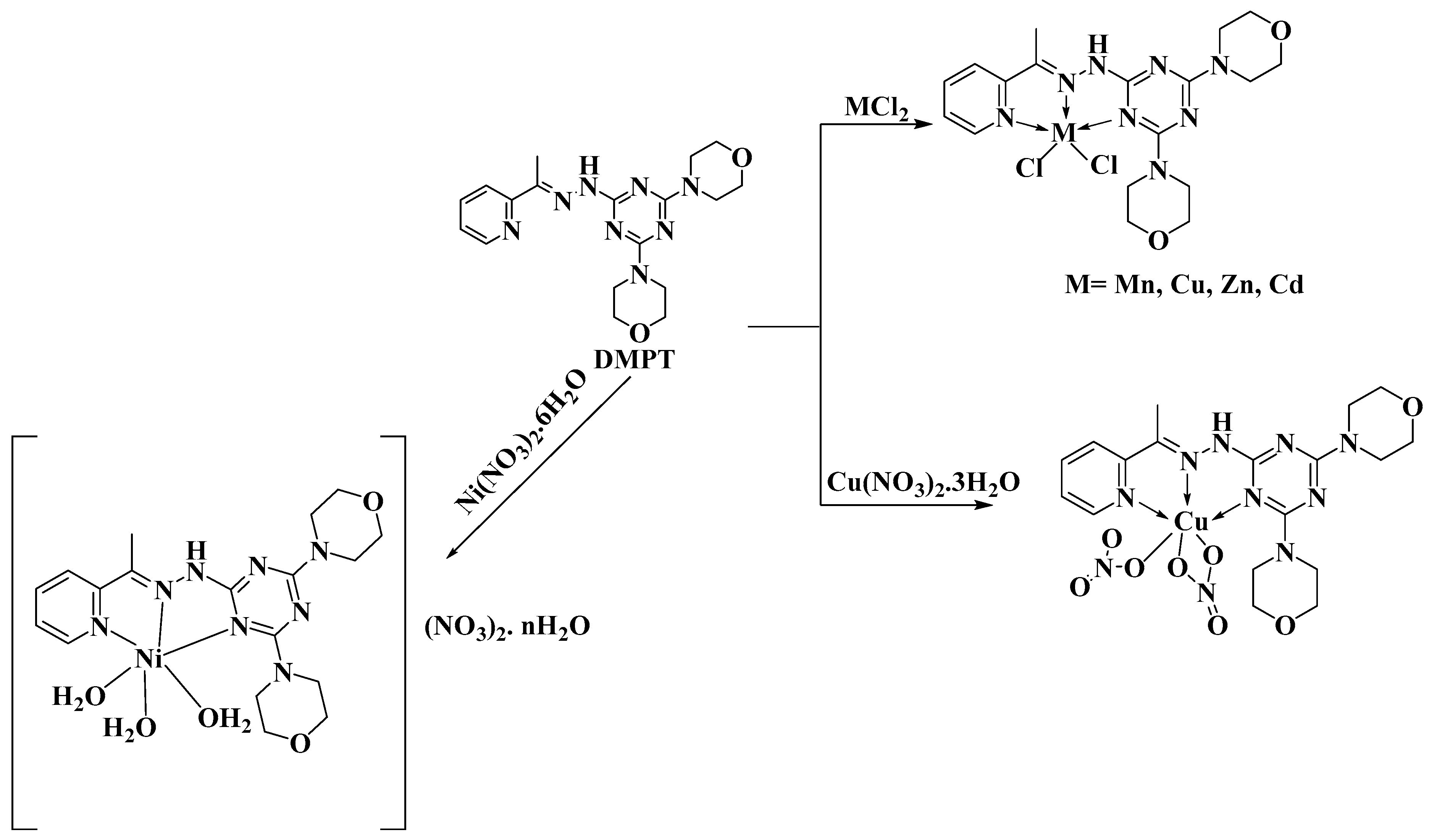
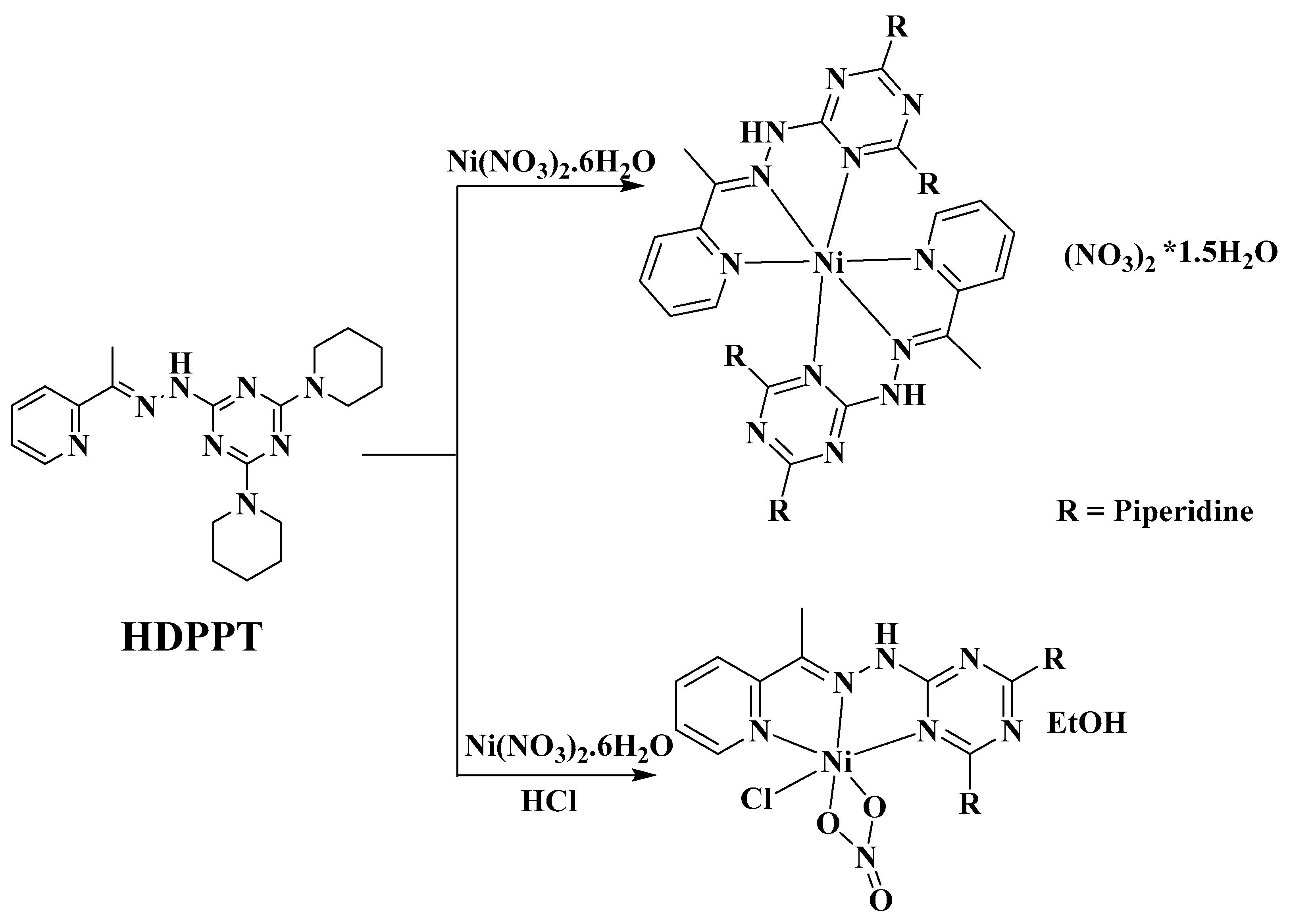
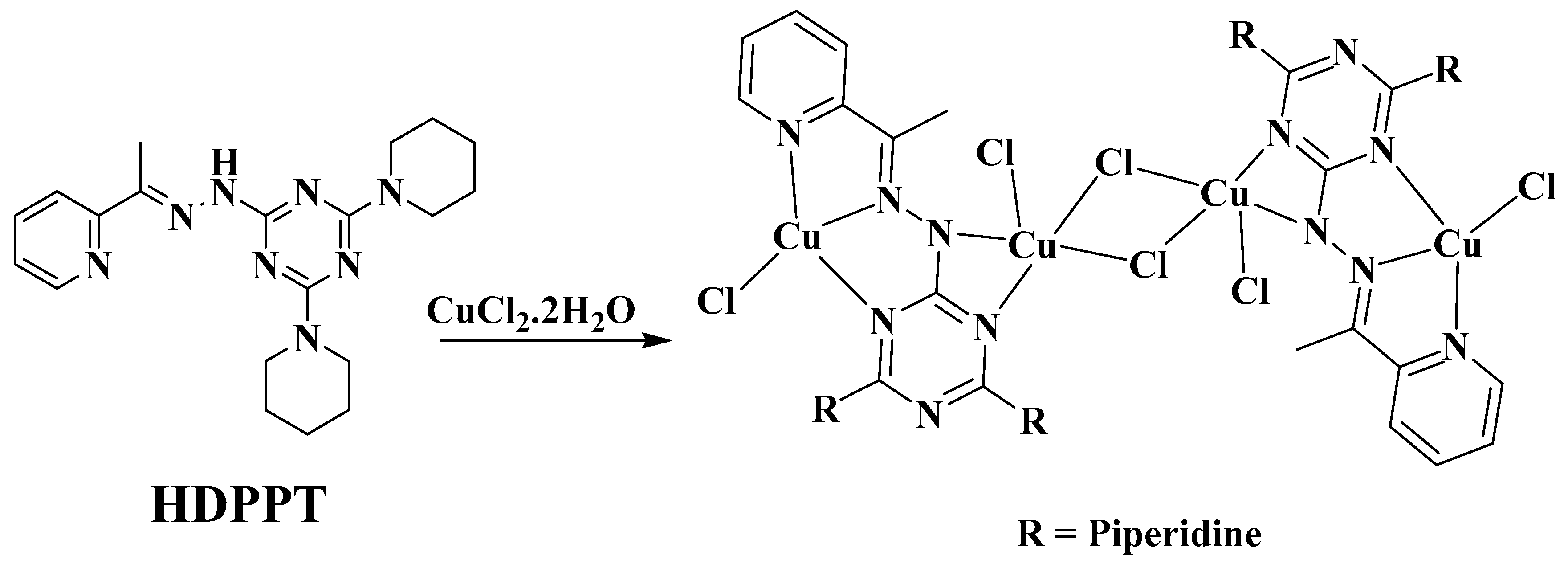
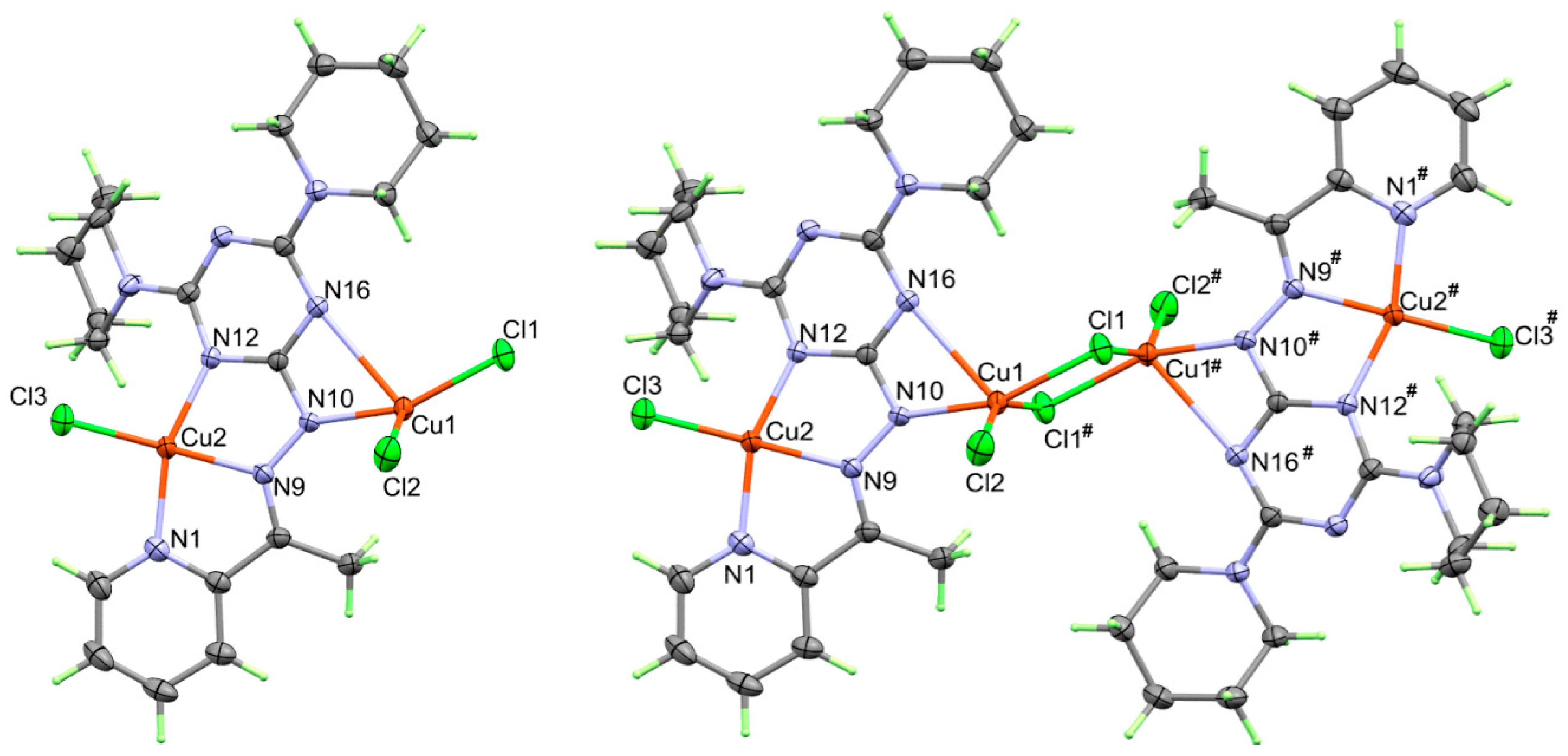

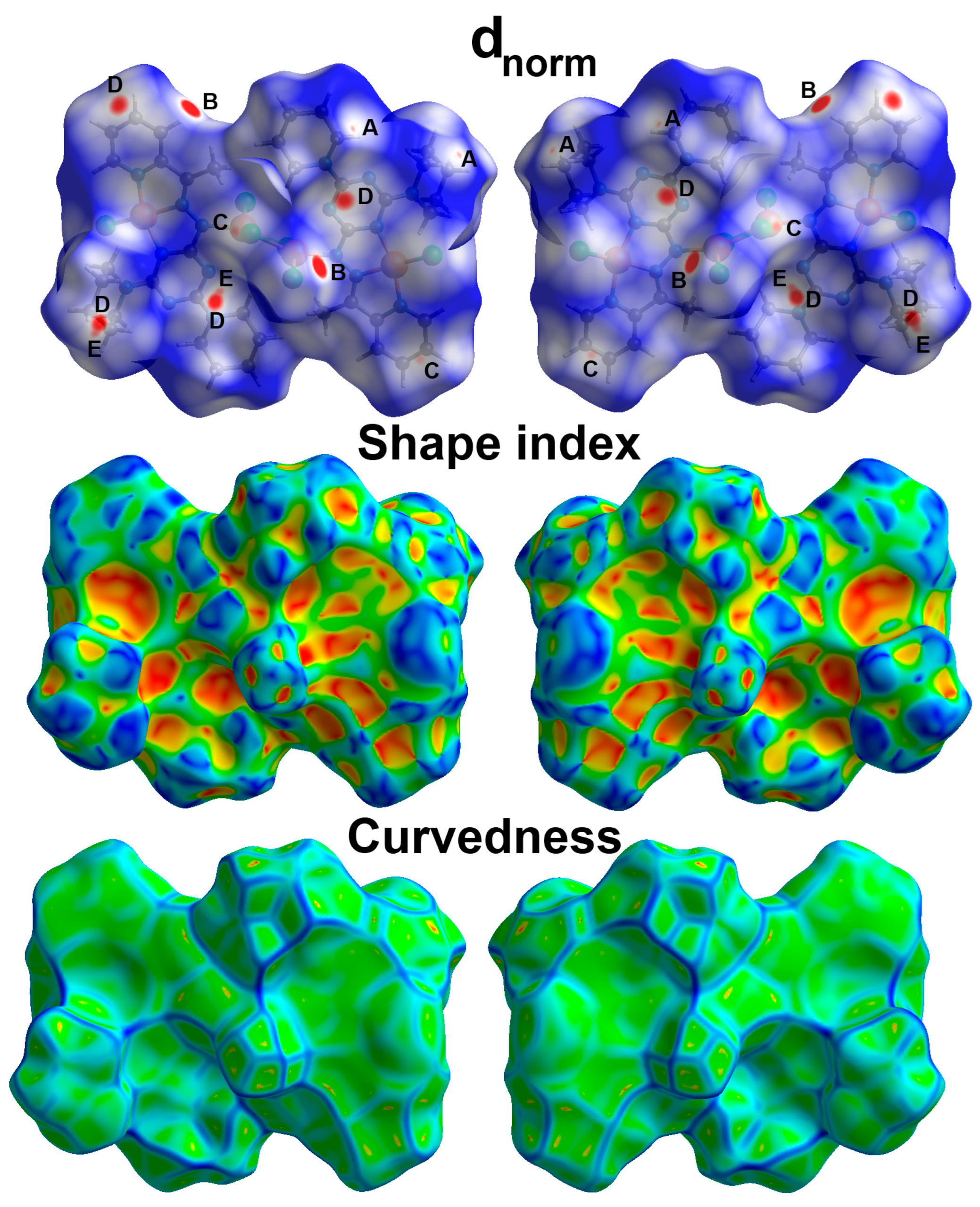
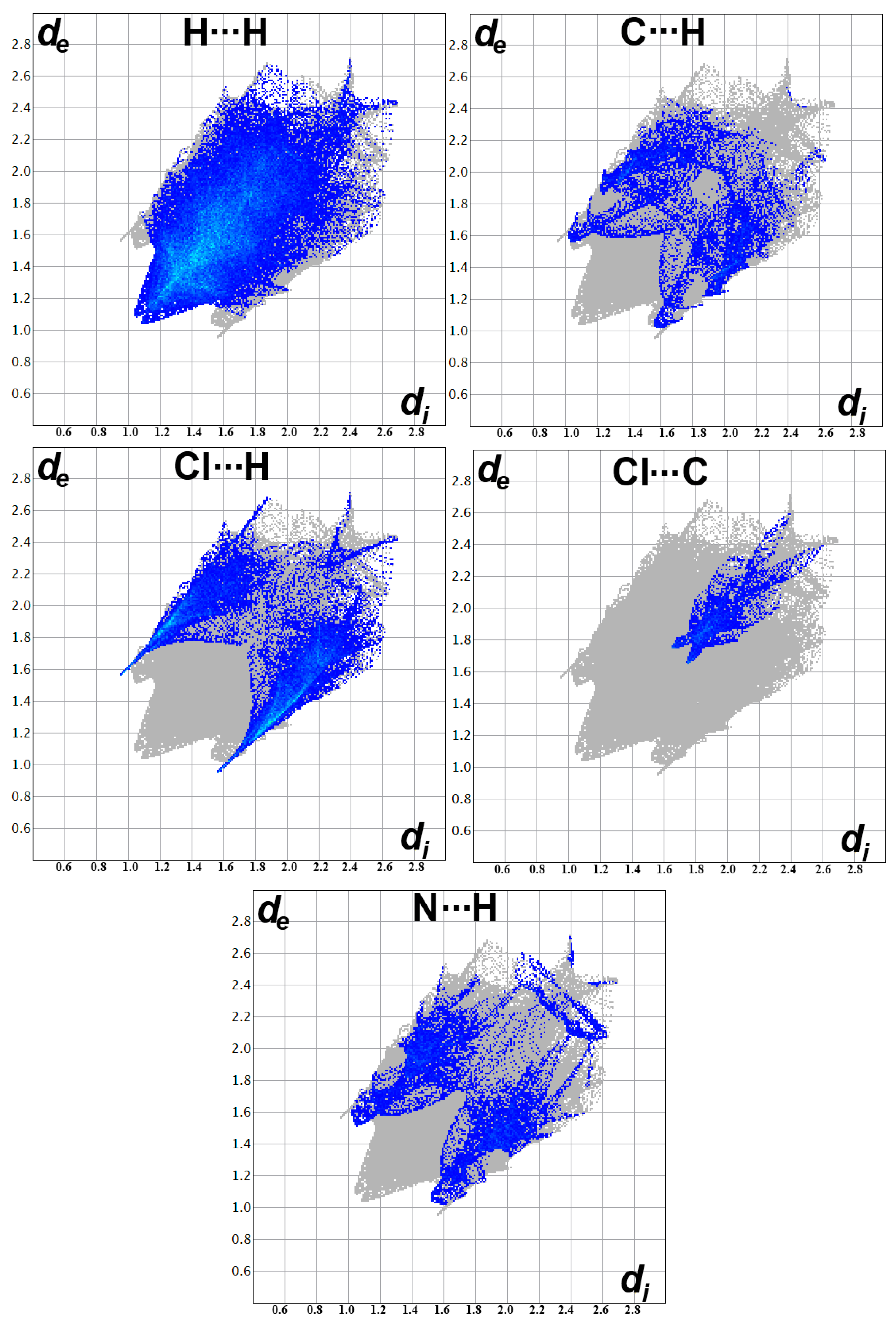
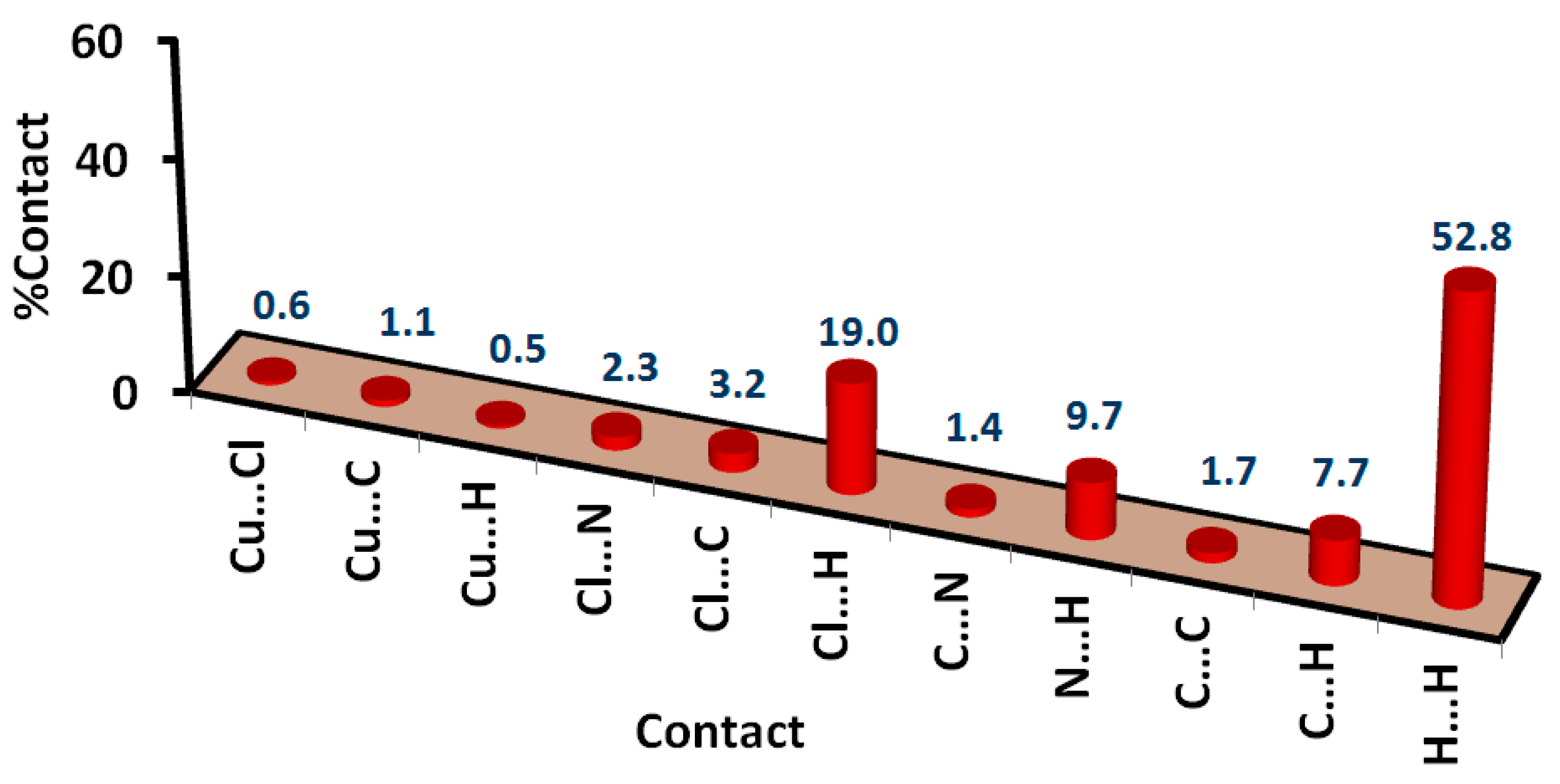
| Bond | Distance | Bond | Distance |
|---|---|---|---|
| Cu1-Cl1 # | 2.3144(5) | Cu2-Cl3 | 2.2156(5) |
| Cu1-Cl1 | 2.2801(5) | Cu2-N1 | 1.9899(16) |
| Cu1-Cl2 | 2.2291(5) | Cu2-N9 | 1.9539(15) |
| Cu1-N10 | 1.9702(15) | Cu2-N12 | 1.9940(15) |
| Cu1-N16 | 2.643(2) | ||
| Bonds | Angle | Bonds | Angle |
| Cl1-Cu1-Cl1 # | 85.566(18) | N1-Cu2-Cl3 | 98.78(5) |
| Cl2-Cu1-Cl1 | 95.05(2) | N1-Cu2-N12 | 156.68(6) |
| Cl2-Cu1-Cl1 # | 151.04(2) | N9-Cu2-Cl3 | 159.92(5) |
| N10-Cu1-Cl1 # | 92.43(5) | N9-Cu2-N1 | 80.22(6) |
| N10-Cu1-Cl1 | 160.21(5) | N9-Cu2-N12 | 79.38(6) |
| N10-Cu1-Cl2 | 96.13(5) | N12-Cu2-Cl3 | 104.26(5) |
| Cu1-Cl1-Cu1 # | 94.432(18) |
| Contact | Distance |
|---|---|
| N16…H20A | 2.572 |
| C15…H20A | 2.599 |
| C15…H4 | 2.810 |
| Cl2…H3 | 2.513 |
| Cl1…C5 | 3.403 |
| H24A…H22B | 2.138 |
| Microorganism | HDPPT b | [Cu4(DPPT)2Cl6] | [Ni(HDPPT)2](NO3)2 b | [Ni(HDPPT)(NO3)Cl] b | Control |
|---|---|---|---|---|---|
| A. fumigatus | NA c (ND) d | 17(78) | 20 (312) | 18 (312) | 17(156) e |
| C. albicans | NA c (ND) d | 19(312) | 21 (312) | 19 (312) | 20(312) e |
| S. aureus | NA c (ND) d | 26(4.8) | 7 (5000) | 8 (2500) | 24(9.7) f |
| B. subtilis | 10 (1250) | 25(9.7) | 19 (312) | 22 (78) | 26(4.8) f |
| E. coli | NA c (ND) d | 20(78) | NA b (ND) c | NA b (ND) c | 30(4.8) f |
| P. vulgaris | NA c (ND) d | 22(39) | NA b (ND) c | NA b (ND) c | 25(4.8) f |
| Compound | [Cu4(DPPT)2Cl6] |
|---|---|
| CCDC | 2287200 |
| Empirical formula | C40H54Cl6Cu4N16 |
| Formula weight | 1225.88 |
| Temperature/K | 173 |
| Crystal system | monoclinic |
| Space group | P21/c |
| a/Å | 12.9169(9) |
| b/Å | 19.6681(12) |
| c/Å | 9.7335(6) |
| α/° | 90 |
| β/° | 96.8998(19) |
| γ/° | 90 |
| Volume/Å3 | 2454.9(3) |
| Z | 2 |
| ρcalcg/cm3 | 1.658 |
| μ/mm−1 | 2.085 |
| F(000) | 1248 |
| Crystal size/mm3 | 0.09 × 0.06 × 0.04 |
| Radiation | Mo Kα (λ = 0.71075) |
| 2Θ range for data collection/° | 3.176 to 50.73 |
| Index ranges | −15 ≤ h ≤ 15, −23 ≤ k ≤ 23, −11 ≤ l ≤ 11 |
| Reflections collected | 26,025 |
| Independent reflections | 4508 [Rint = 0.0212, Rsigma = 0.0153] |
| Data/restraints/parameters | 4508/0/299 |
| Goodness-of-fit on F2 | 1.023 |
| Final R indexes [I ≥ 2σ (I)] | R1 = 0.0205, wR2 = 0.0506 |
| Final R indexes [all data] | R1 = 0.0261, wR2 = 0.0528 |
| Largest diff. peak/hole/e Å−3 | 0.27/−0.22 |
Disclaimer/Publisher’s Note: The statements, opinions and data contained in all publications are solely those of the individual author(s) and contributor(s) and not of MDPI and/or the editor(s). MDPI and/or the editor(s) disclaim responsibility for any injury to people or property resulting from any ideas, methods, instructions or products referred to in the content. |
© 2023 by the authors. Licensee MDPI, Basel, Switzerland. This article is an open access article distributed under the terms and conditions of the Creative Commons Attribution (CC BY) license (https://creativecommons.org/licenses/by/4.0/).
Share and Cite
Al-Rasheed, H.H.; AL-khamis, S.A.; El-Faham, A.; Barakat, A.; Slawin, A.M.Z.; Woollins, J.D.; Soliman, S.M. Synthesis, X-ray Structure, Hirshfeld Surface Analysis and Antimicrobial Assessment of Tetranuclear s-Triazine Hydrazine Schiff Base Ligand. Inorganics 2023, 11, 357. https://doi.org/10.3390/inorganics11090357
Al-Rasheed HH, AL-khamis SA, El-Faham A, Barakat A, Slawin AMZ, Woollins JD, Soliman SM. Synthesis, X-ray Structure, Hirshfeld Surface Analysis and Antimicrobial Assessment of Tetranuclear s-Triazine Hydrazine Schiff Base Ligand. Inorganics. 2023; 11(9):357. https://doi.org/10.3390/inorganics11090357
Chicago/Turabian StyleAl-Rasheed, Hessa H., Sarah A. AL-khamis, Ayman El-Faham, Assem Barakat, Alexandra M. Z. Slawin, John Derek Woollins, and Saied M. Soliman. 2023. "Synthesis, X-ray Structure, Hirshfeld Surface Analysis and Antimicrobial Assessment of Tetranuclear s-Triazine Hydrazine Schiff Base Ligand" Inorganics 11, no. 9: 357. https://doi.org/10.3390/inorganics11090357
APA StyleAl-Rasheed, H. H., AL-khamis, S. A., El-Faham, A., Barakat, A., Slawin, A. M. Z., Woollins, J. D., & Soliman, S. M. (2023). Synthesis, X-ray Structure, Hirshfeld Surface Analysis and Antimicrobial Assessment of Tetranuclear s-Triazine Hydrazine Schiff Base Ligand. Inorganics, 11(9), 357. https://doi.org/10.3390/inorganics11090357










